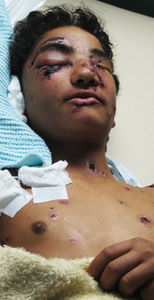
The Times has uncovered dozens of incidents in which doctors say that civilians have been wounded by white phosphorus, which burns at extremely high temperatures until its oxygen is cut off. Last week UN officials in Gaza were certain that their compound had been hit by white phosphorus shells.
Israel's three-week offensive in the Gaza Strip may be over but Mahmoud Mattar, 14, will not be able to sense the quiet that has descended on his home town of Jabalya.
Blinded in both eyes, with third-degree burns over much of his torso, Mahmoud lies unconscious in the Sheikh Zayid Hospital on the outskirts of Cairo. He has said little since January 6, when an Israeli attack on his village in northern Gaza left him nearly dead on the street outside his mosque. Doctors say that he will never see again - and that the burns on his body were caused by white phosphorus, a controversial incendiary weapon that Israel originally denied using.
"He was walking to the mosque when the attack started," his uncle, Nahad Mattar, said. "Two of his friends who were walking with him were killed instantly. Their bodies are in pieces. He was hit by something and his body began to burn.
"There were bits of blood and skin all over him. We couldn't tell what was his and what was other people." Witnesses in Jabalya describe thesigns of white phosphorus shelling - thick white smoke, a strong smell and fires that burn until covered with sand - and say that dozens more experienced burns in the same attack.
Yesterday Amnesty International said its team had found proof that Israeli forces were using white phosphorus in densely-populated residential areas in Gaza City and in the north. "We saw streets and alleyways littered with evidence, including still burning wedges and the remnants of the shells and canisters fired by the Israeli army," said Christopher Cobb-Smith, a weapons expert touring Gaza as part of Amnesty's fact-finding team.
Medical experts in Gaza said that they were collecting tissue samples from burns victims to test for white phosphorus, but were unsure when they could be sent to the laboratories. Doctors in Egypt have barred journalists from hospitals where hundreds of wounded Palestinians have been taken. They would not comment publicly on the wounds, but in private said that they had "no doubt" they were treating chemical phosphorus burns.
Allison El Soukary, a British nurse who lives in Cairo and worked in an Essex burns unit for several years, said: "The shapes of the burns, small circular splotches that go deep into the skin - those are where the chemical hit and burnt through." Doctors are unsure how long it will take for Mahmoud to recover. His breathing is ragged and unsteady and he does not understand where he is or why he is in pain. On the day he was wounded his father and brother took him to Gaza City's Shifa Hospital. They said the prayer for the dead and were sure he was going to die. When they got to the hospital there were no beds, so they laid him on the ground with all the others.
Because of the extent of his injuries, Mahmoud received special clearance to travel to Egypt for treatment. But the convoy of 14 ambulances that attempted to make their way to the border came under fire and were forced to turn back. Two days later they were able to cross through the Rafah border crossing with Egypt.
In the Sheikh Zayid Hospital there are 29 patients who were pulled from the fighting in Gaza. At least five have burns consistent with phosphorus, say experts. Muhammad Hassanat, 26, and his neighbour Tamer Omar Ellouhe, 18, both lost their legs when a volley of artillery fire hit their Gaza City suburb of Zeitoun - the same area where dozens of members of the Samouni family were buried alive in an Israeli strike. The survivors were forced to wait several days for ambulances to get through the fighting. Yesterday Samouni family corpses were still being pulled from the rubble.
Mahmoud Hassanat, Muhammad's brother, now sits in the polished marble hospital cafeteria, dividing his worry between family members still in Gaza and the patients upstairs.
"I had left him for dead," he said. "I went to cemetery to prepare a burial plot and our father had gone home to tell our mother that her son was killed. Our mother went running down the street and discovered that he was still breathing a little. Doctors also thought he would die, but he is alive."
Without his legs and with a broken arm, jaw, and ribs, Muhammad will no longer be able to support his wife and four children in his old job as an electrician. "We were attacked by an army. But we are not an army, we have no way to defend ourselves," said his brother. "We will go back to our home. We are not political but we will go on with Hamas. This is how it is."



Reader Comments
to our Newsletter